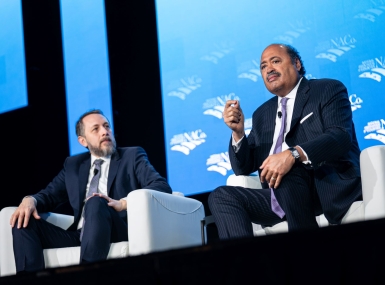What’s the Big Deal About Big Data?
Author

Dr. Alan Shark
Upcoming Events
Related News

Government has been collecting data since the beginning of time. So, what has changed? We now we have something called big data. Yes, with the advent of super-fast computing we are learning to cultivate data in ways not thought possible just a few years ago. But that is only one part of the story as web 2.0 technologies allow citizens to not only digest content — but to create data. Those who study the information explosion claim that 90 percent of the world’s data has been generated since 2010 and, add to that, we create 2.5 quintillion bytes of data every day. (A quintillion is a billion billion.)
Corporate America is way ahead of local governments in collecting everything they can about an individual’s buying habits, preferences, income sources, movements, as well as likes and dislikes to name a few. We are tracked the moment we log onto a commercial website— be it Amazon or Facebook or Twitter.
Big data has become a big business with data scientists and data analysts becoming one of the most sought-after professions. Today, there are at least 20 local governments that have created the position of chief data officer.
Big Data vs. Open Data
The terms “big data” and “open data” are popular right now, and this creates some confusion as open data and big data are related — but different.
Numerous counties have created separate “open data portals” that make available government-collected information — data sets — to the public. Data sets made public might include public works project accomplishments and metrics, pothole repair metrics, public safety response times, restaurant health violations and in some cases — public employee salaries. Open data has been promoted as a means of enhancing government transparency. And transparency has become a positive buzz-word for those running for office. The new mantra is “open government is good government.”
Big data is different and a definition is in order. One of the better definitions comes from IBM, which defines big data as: Big data is being generated by everything around us at all times.
Every digital process and social media exchange produces it. Systems, sensors and mobile devices transmit it. Big data is arriving from multiple sources at an alarming velocity, volume and variety. To extract meaningful value from big data, you need optimal processing power, analytics capabilities and skills.
The Internet and, the “Internet of everything” describes the conduit for all data that crisscrosses the globe and back in an instant. In 2014, more data was transmitted and received via the Internet, surpassing voice communications. Big data also comes in many forms such as structured data and non-structured data.
Examples of structured data would include nine-digit Social Security numbers or fixed fields within a database. Unstructured data might include telemetry from mobile devices, data from web pages or social media, automated vehicle or school bus location systems, etc.
Metadata is another form of data which can play a significant role too. Simply put, it is data about data. It can be used to analyze trends, usage, manage resources and better understand relationships between users and devices. Instead of traditional research methods that rely on surveys and samples, big data can replace samples with live data from a larger and more reliable pool of data sets.
So, while open data and big data enjoy many similarities, they usually focus on different outcomes. Counties are using both to better inform the public about what they are doing (open) and to use data (big) for enhanced data-driven decision-making. In almost every case, the focus is citizen-centric.
The rationale here is that the more we know about our citizens or local businesses, the better a county can deliver an appropriate service, message or system. In many instances, the public has become a willing partner toward sharing data that benefits all.
Now that we have a better understanding of what big data is, here are a few examples of how they are being applied:
Example 1: Big data has played a significant role in traffic reporting. Have you ever wondered just how Google Maps can be so accurate in displaying in graphic colors how traffic is moving (or not) in just about any part of the country?
The data is mostly coming from metadata derived from everyone’s cellphones as they traverse our roadways. Google computers can tell traffic flow by the movement of vehicles and the time it takes for a signal to identify itself with any given cell tower.
The data collected is metadata, so don’t be alarmed as they are more interested in your movement in aggregate terms as opposed to learning exactly who you are.
Example 2: Big data has played a significant role in better understanding the opioid crisis. Counties can tap into numerous databases from law enforcement, social services and health facilities and plot the information to maps showing the location of each fatality.
This can greatly assist public officials to better focus on prevention and intervention strategies since they can better focus their efforts and resources to where they may be most needed.
Example 3: Transportation officials use big data to better understand how citizens move about the county whether one is using a car, truck, bike, walk or public transportation. Data collected can lead to better street and highway planning, bus-stop placement and public transportation routes.
Example 4: Public safety uses big data to analyze crime statistics that includes types of incident, exact location, time of incident, while also at the same time looking for patterns. This type of analysis is often referred to as predictive analytics, where the focus is on anticipating crimes and deploying resources to prevent crime.
The digital age has provided unimaginable quantities of data delivered with amazing speed. Data by itself begins with a series of 1’s and 0’s and when structured properly, provides for greater human comprehension. From data we gain information, and when we have good and verifiable information, we gain wisdom.
Big data has become a big deal because when used to its full potential, it can help guide counties toward better resource management, healthier and safer communities, as well as improved citizen support and understanding.
Attachments
Related News

Multi-State Information Sharing and Analysis Center (MS-ISAC) loses federal funding
On March 11, the Cybersecurity and Infrastructure Security Agency (CISA) announced a $10 million cut in funding for the Multi-State Information Sharing and Analysis Center (MS-ISAC), which provides critical local assistance for cybersecurity threat detection and analysis resources and support.

Risk mitigation, education top counties’ AI prep goals
Members of NACo’s Artificial Intelligence Exploratory Committee spent a year considering the capabilities, opportunities, threats and best practices that the rapidly developing technology sector poses for county governments.

Panel touts bridging digital skills gap
Digital literacy skills are becoming increasingly crucial not just for county officials, but their constituents, too.